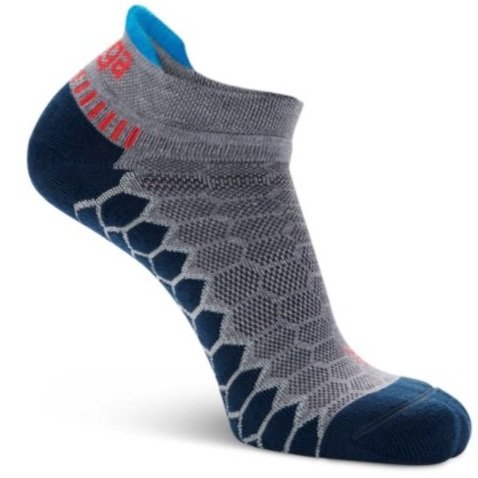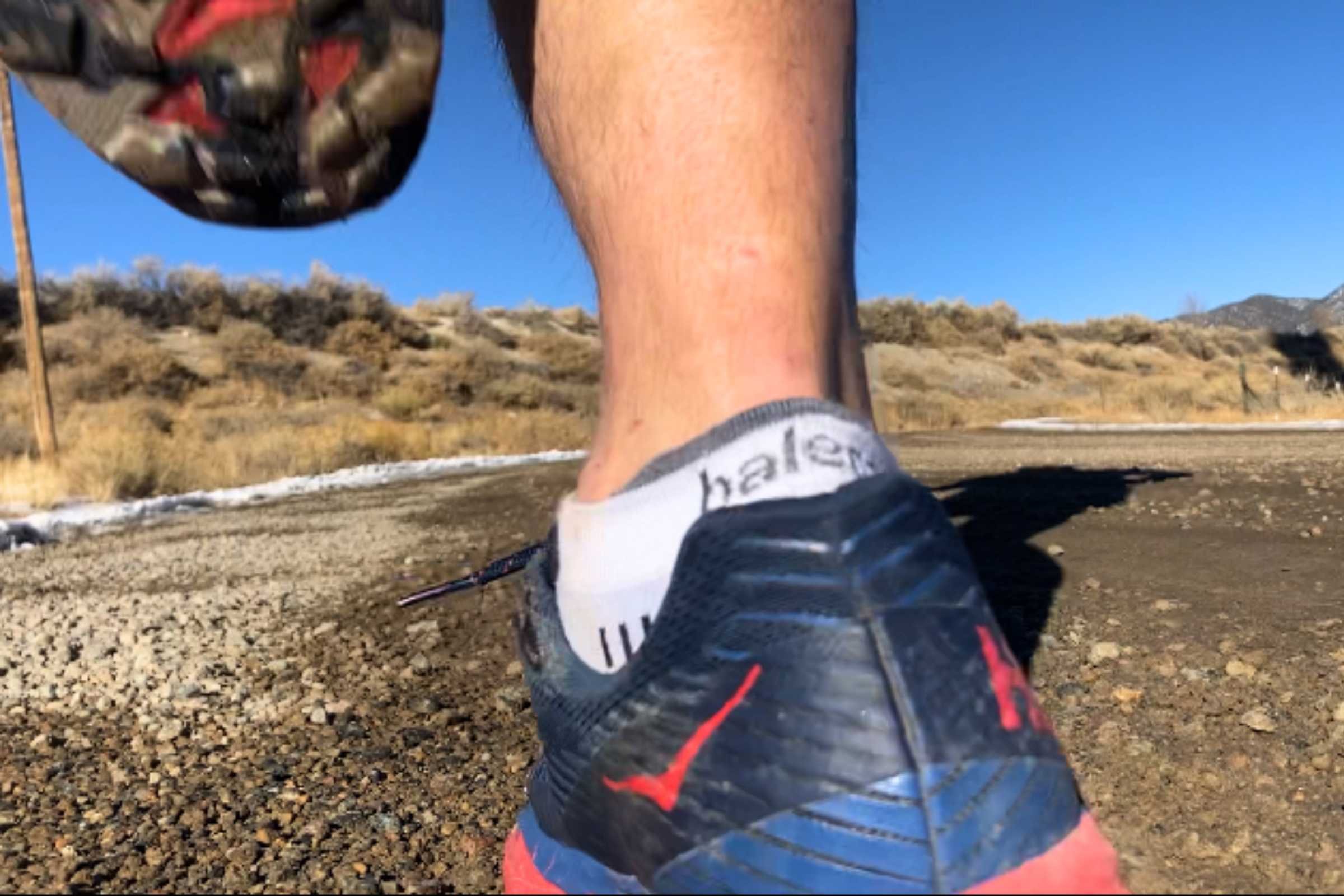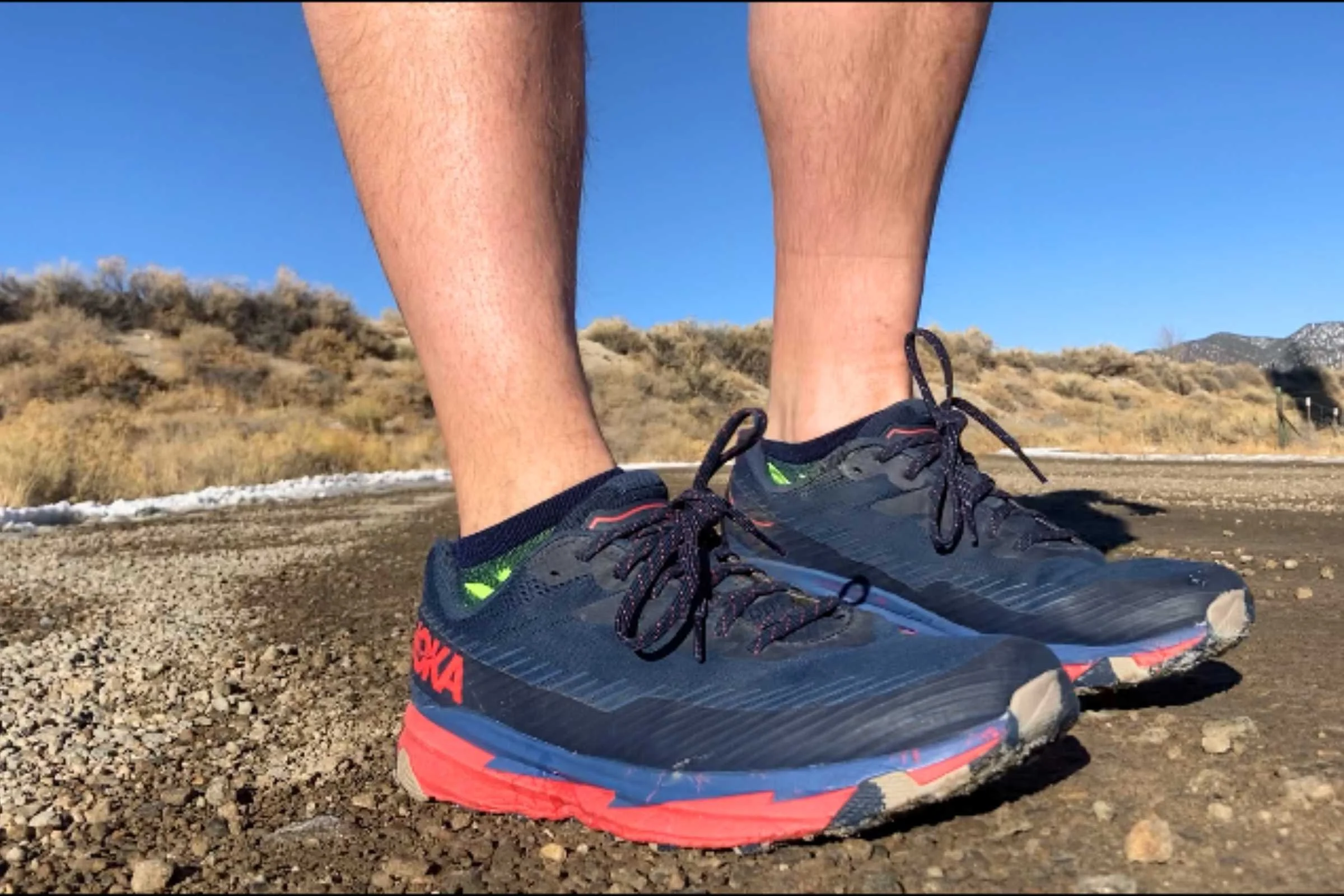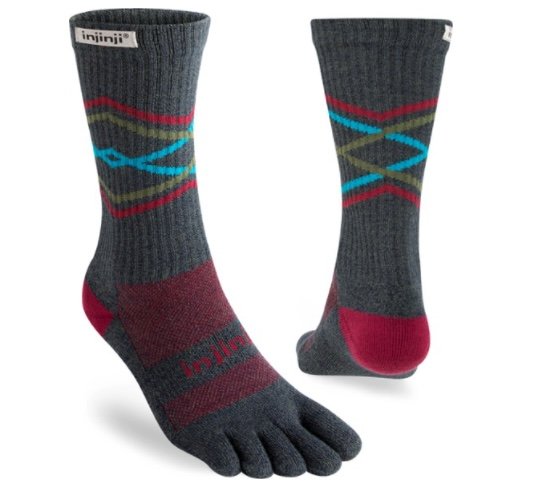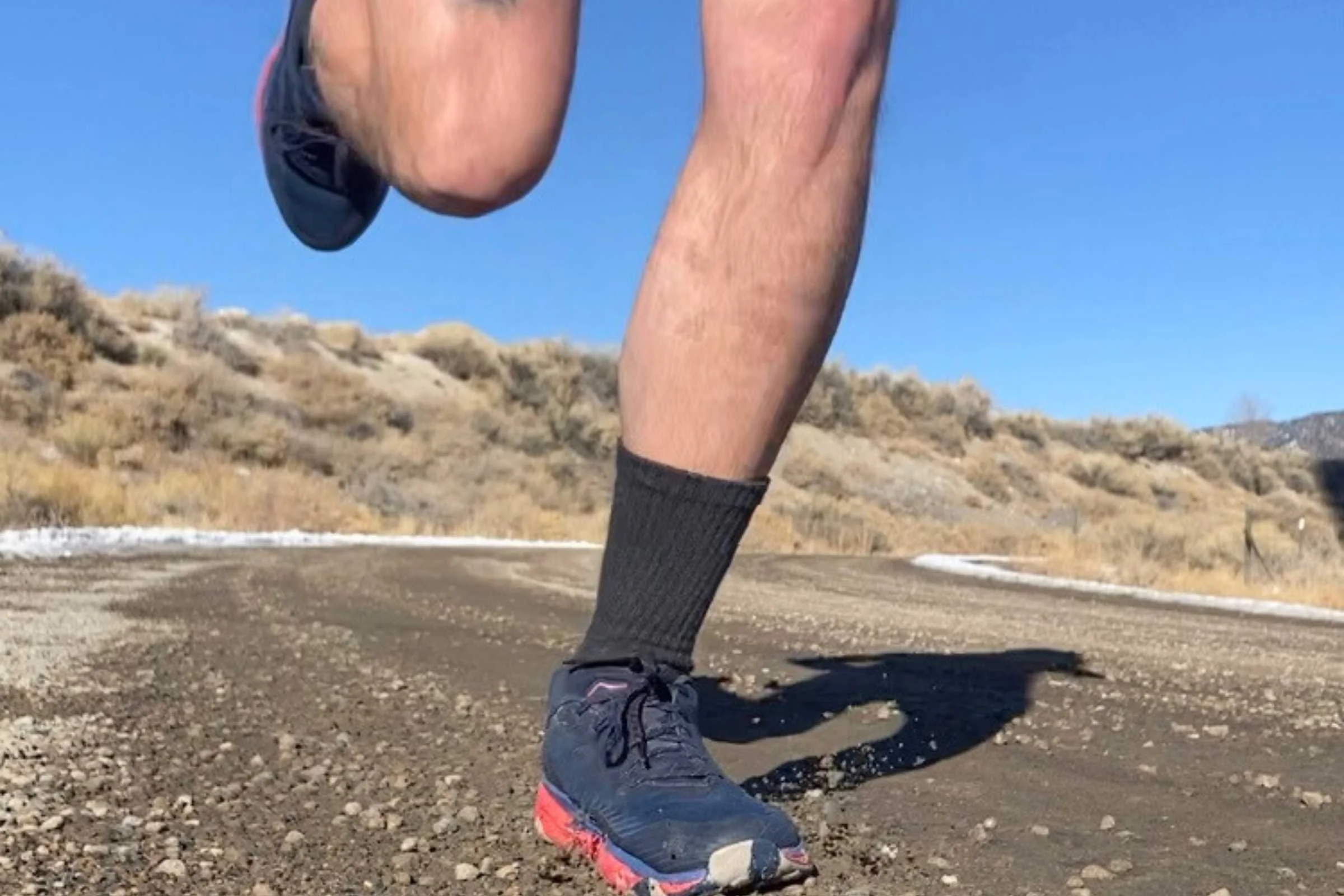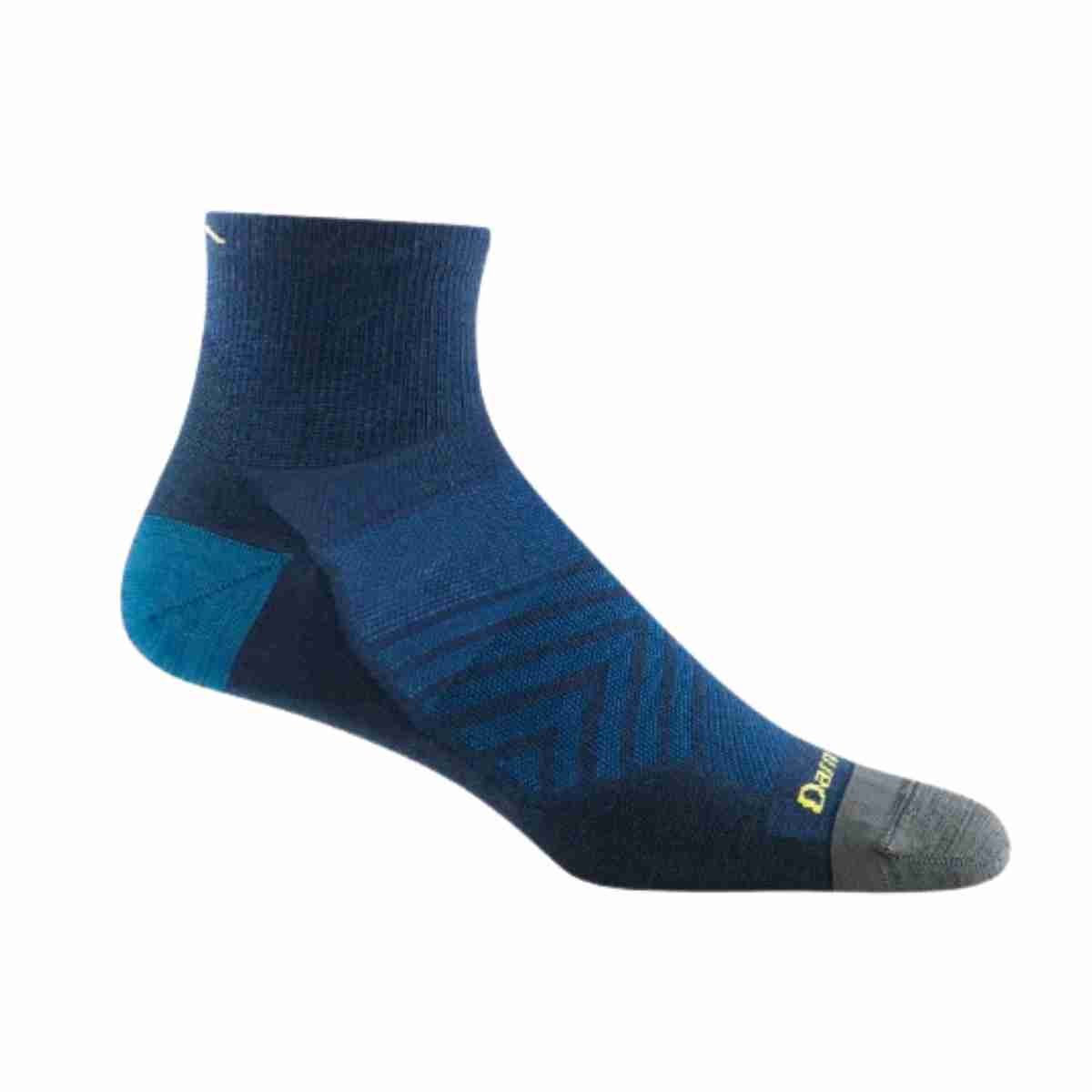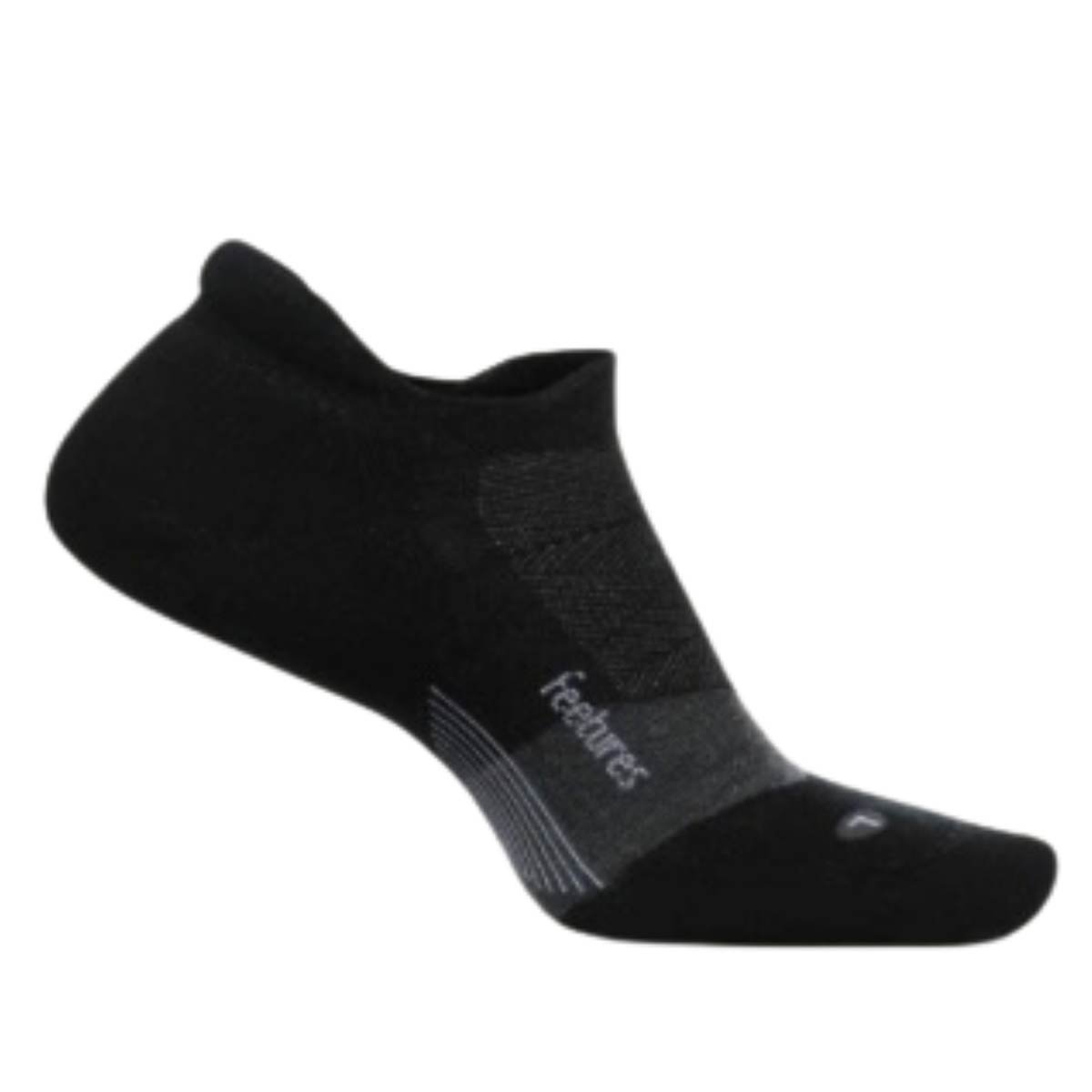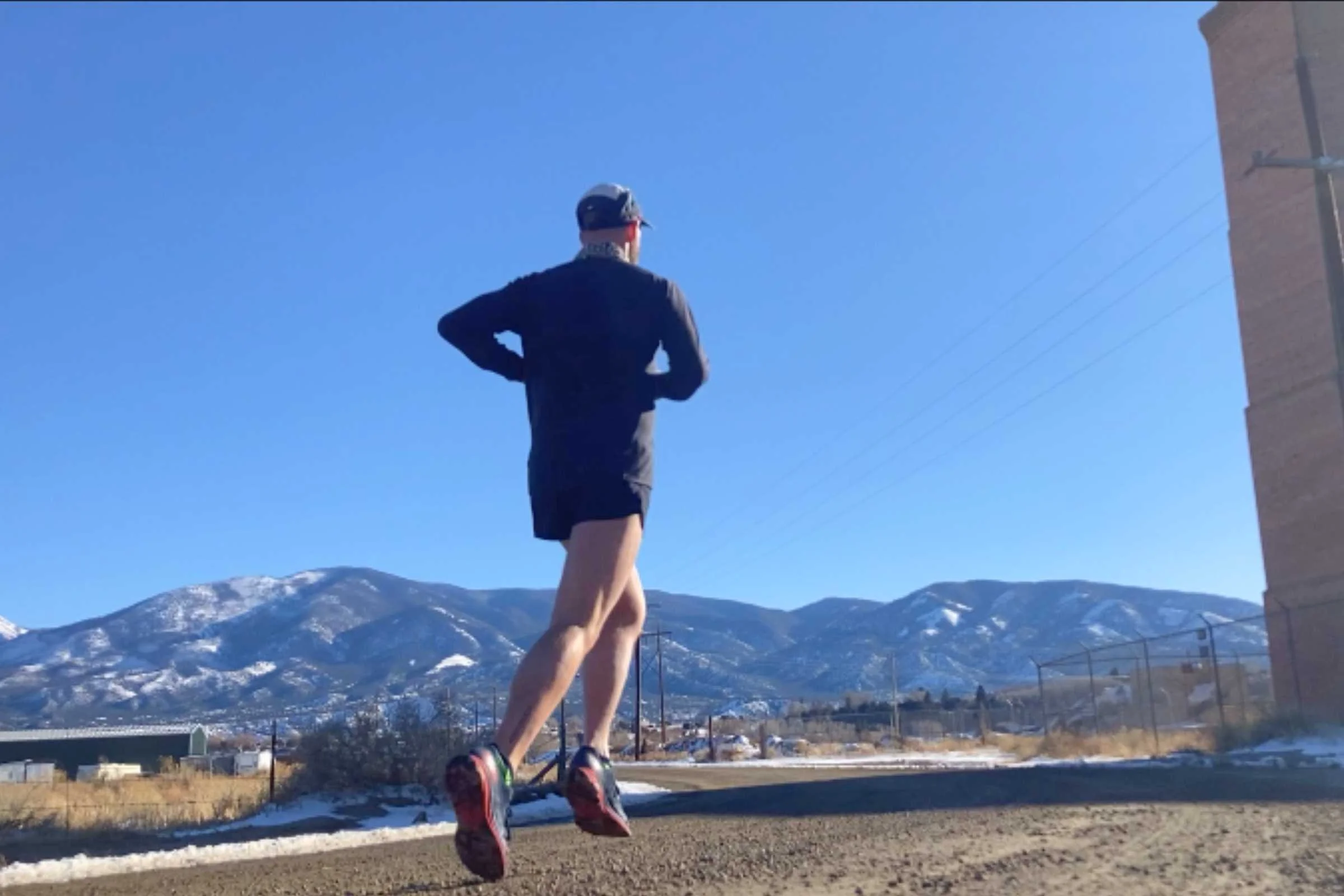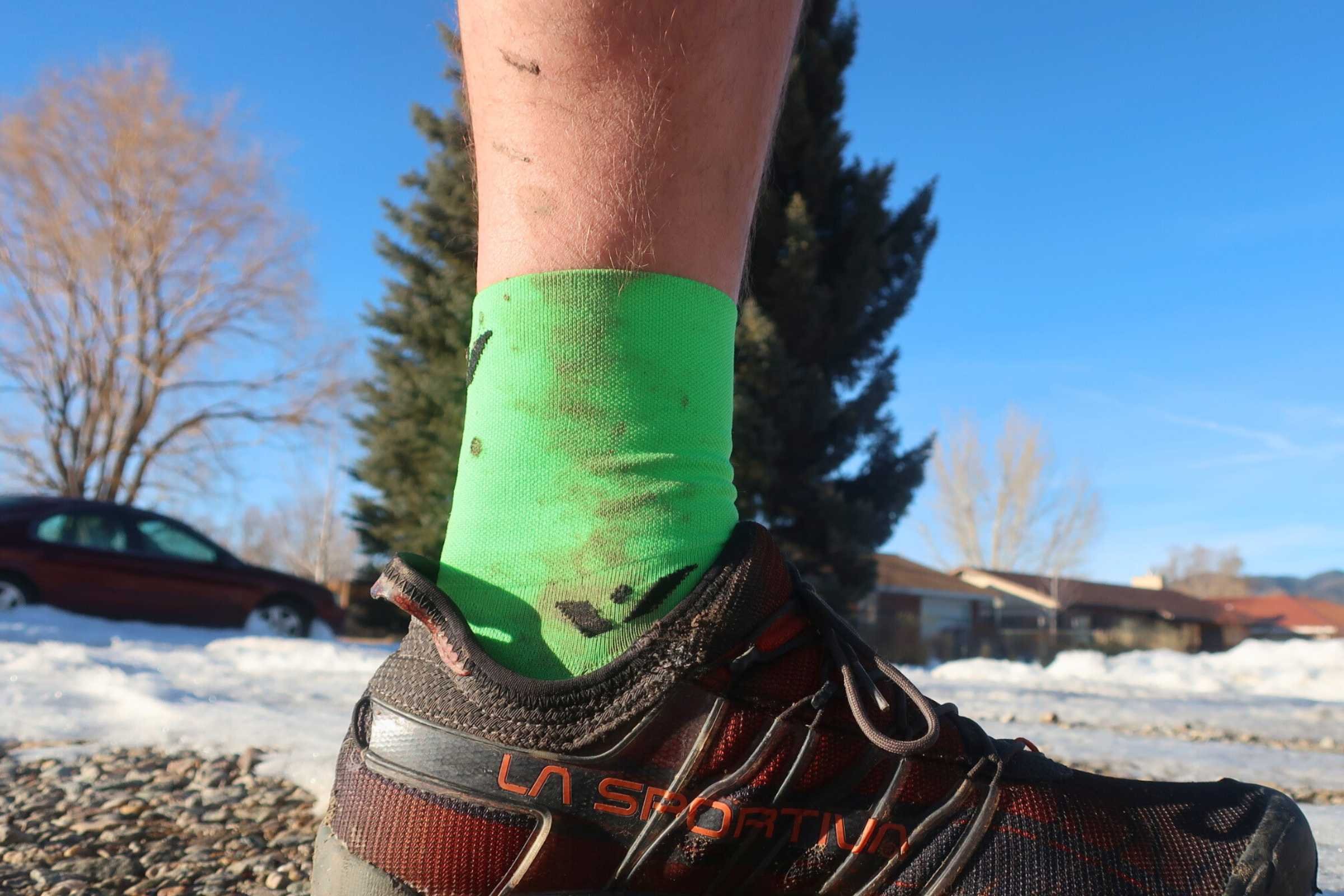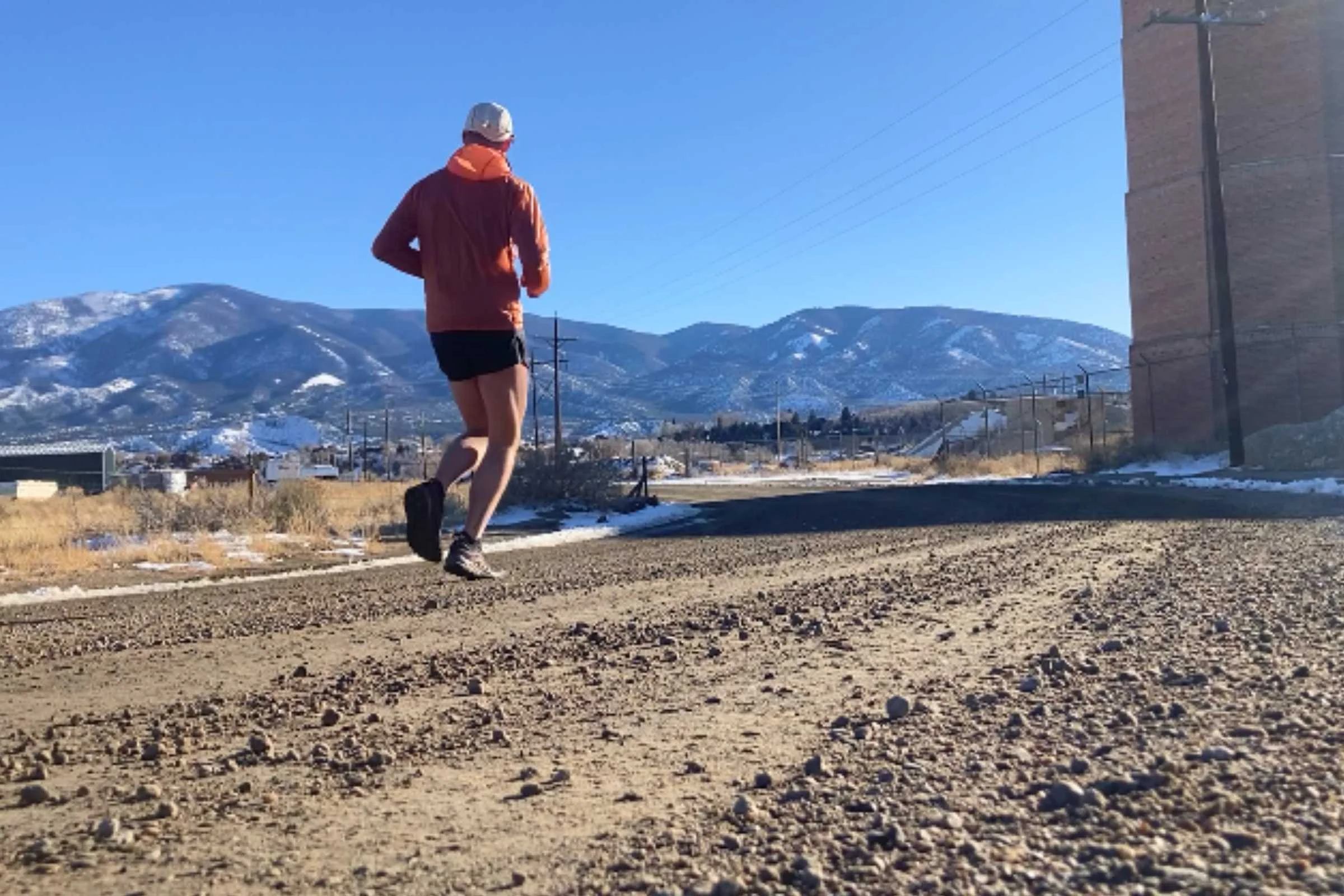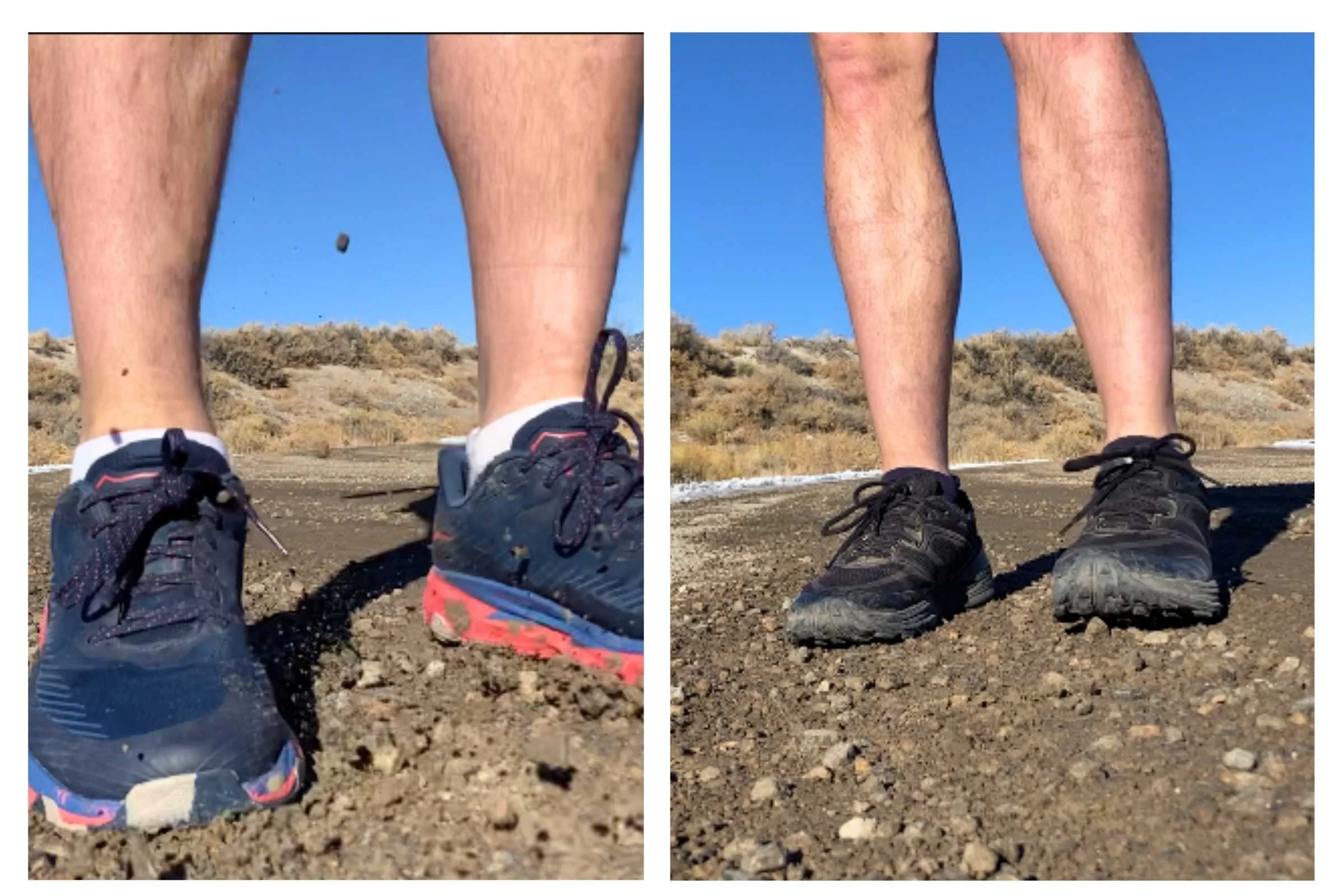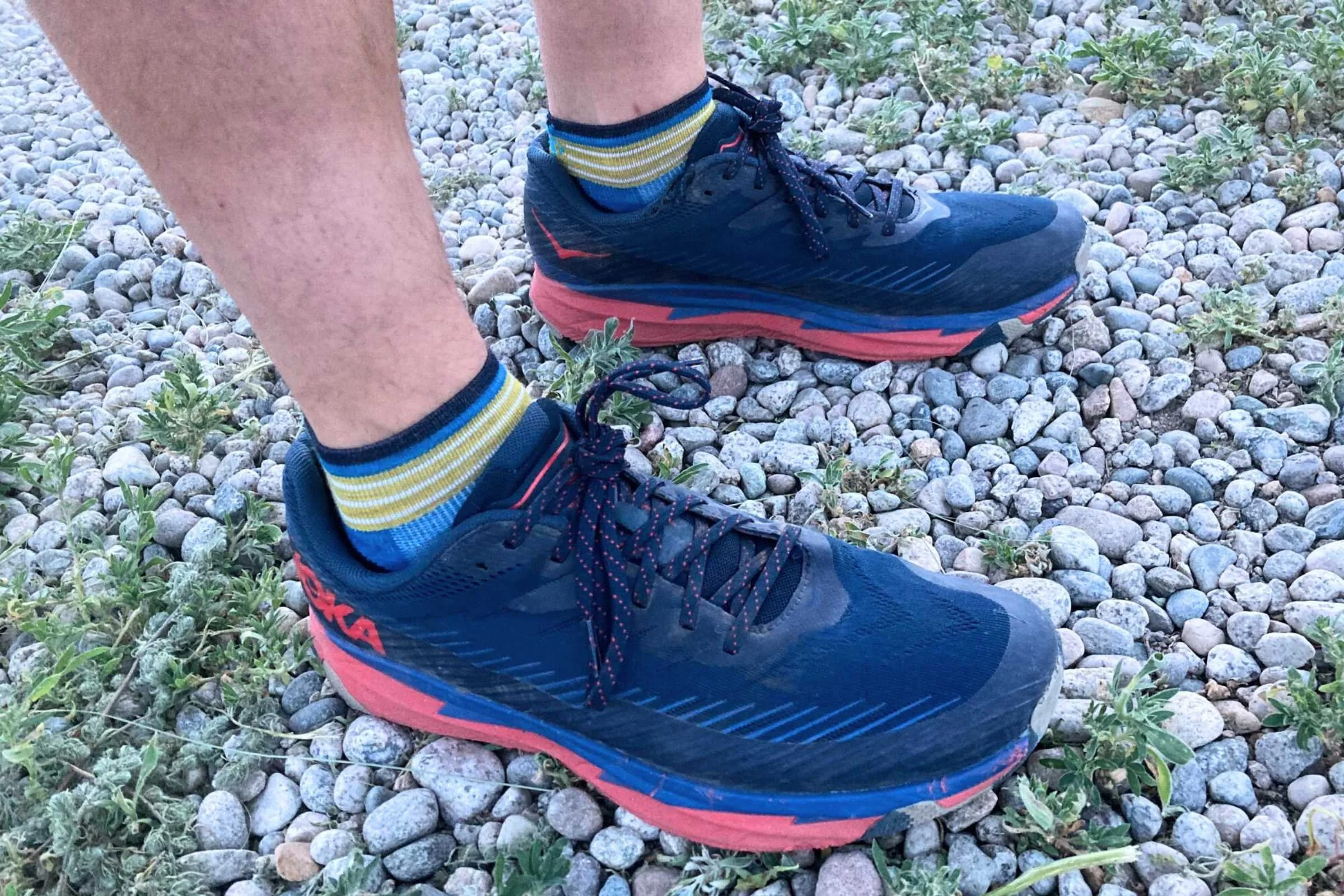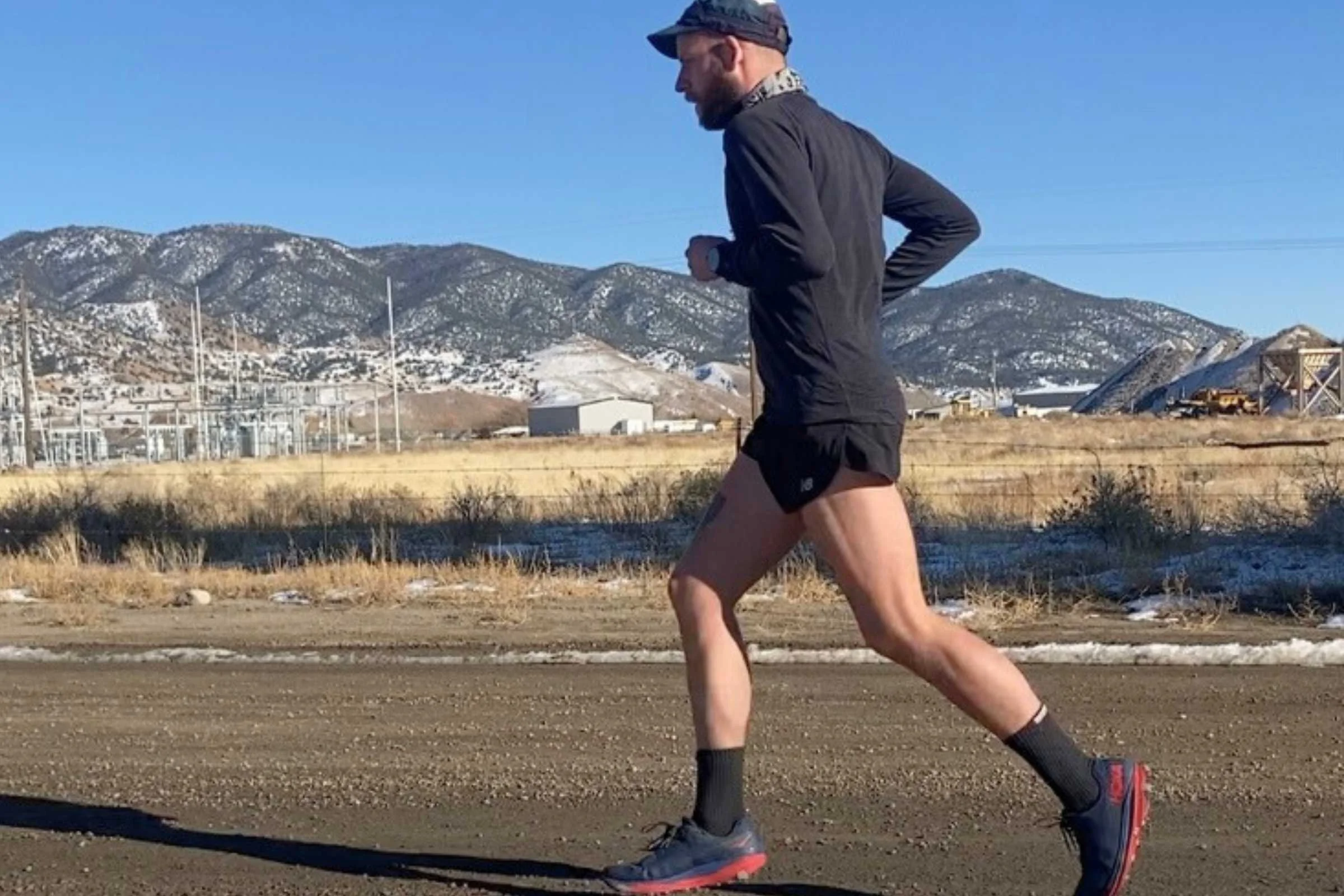Best Running Socks of 2025
The best socks for runners— to prevent blisters, hot weather runs, WINTER RUNNING, compression and toe socks
July 7th, 2025, with 4 more models tested
Home >Gear Reviews >Apparel
After years of side-by-side testing running socks across Colorado, Arizona, and California—spanning roads to rocky trails to dry winter snow and spring slush—we've identified the 6 best running socks. Our comprehensive evaluation methodology involved 9,000+ combined running and hiking miles of gear testing. We compared moisture-wicking properties, cushioning levels, and fit performance across temperatures ranging from 20°-100+°F on surfaces from paved roads to technical alpine routes.
Through rigorous field testing in the Arkansas Valley high desert at 7,000+ feet elevation, we evaluated each sock's performance in blister prevention, breathability, durability, and temperature regulation. Our testing prioritized the factors that matter most to runners: moisture management, seamless construction, cushioning optimization, and long-term comfort across varied terrain and conditions.
Our Top Pick: The Balega Silver No Show wins our recommendation as the best overall running sock, delivering the optimal balance of heel security, moderate cushioning, and exceptional breathability with construction that prevents slipping while maintaining perfect temperature control across diverse running conditions.
A runner could technically use any sock for running. But choosing fabrics like merino wool and polyester blends instead of cotton encourages wicking, odor control, abrasion resistance against blisters, and enhances durability. Second only to running shoes, the running sock plays a crucial role in keeping your feet blister-free and generally in good health for happy running, serving as the critical buffer between feet and shoe that keeps you dry mile after mile.
We create reader-supported, objective gear reviews independently selected by our editors. This story may contain affiliate links, which help fund our website. When you click on the links to purchase gear, we may get a commission, allowing us to continue running the site without costing you an extra cent. Thank you for supporting our mission of outdoor coverage for every body! Learn more.
Running Socks Comparison Table
Men’s
| MEN'S RUNNING SOCK | TREELINE AWARD | HEIGHT | CUSHIONING LEVEL | MATERIAL | SIZING |
|---|---|---|---|---|---|
| Balega Silver No Show | Best Running Socks Read why |
No show tab | Medium | 75% Drynamix Polyester, 23% Nylon, 2% Elastane | 5 to 13.5 unisex |
| Swiftwick Aspire Zero | Best Socks for Hot Weather Read why |
No show | None | 55% Nylon, 40% Olefin, 5% Spandex | 3 to 15 unisex |
| Balega Blister Resister Quarter | Best Blister-Preventing Socks Read why |
No-show, quarter, crew | Medium/High | 32% Drynamix Polyester, 32% Polyamide, 30% Mohair, 4% Microfiber, 2% Elastane | 4.5 to 14 unisex |
| Injinji Trail Midweight Mini-Crew | Best Toe Socks Read why |
Mini crew, crew, quarter | Midweight | 39% Coolmax Polyester, 58% Nylon, 3% Lycra | 5 to 13.5 unisex |
| Darn Tough Run Ultra-Lightweight | Best Winter Running Socks Read why |
No show tab, quarter | No Cushion (Cushion also available) | 56% Nylon, 39% Merino Wool, 5% Lycra Spandex | M's 5.5 to 17 |
Women’s
| WOMEN'S RUNNING SOCK | TREELINE AWARD | HEIGHT | CUSHIONING LEVEL | MATERIAL | SIZING |
|---|---|---|---|---|---|
| Balega Silver No Show | Best Running Socks Read why |
No show tab | Medium | 75% Drynamix Polyester, 23% Nylon, 2% Elastane | 5 to 13.5 unisex |
| Swiftwick Aspire Zero | Best Socks for Hot Weather Read why |
No show | None | 55% Nylon, 40% Olefin, 5% Spandex | 4 to 16.5 |
| Balega Blister Resister Quarter | Best Blister-Preventing Socks Read why |
No-show, quarter, crew | Medium/High | 32% Drynamix Polyester, 32% Polyamide, 30% Mohair, 4% Microfiber, 2% Elastane | 4.5 to 14 unisex |
| Injinji Trail Midweight Mini-Crew | Best Toe Socks Read why |
Mini crew, crew, quarter | Midweight | 39% Coolmax Polyester, 58% Nylon, 3% Lycra | 6 to 12 |
| Darn Tough Run Ultra-Lightweight | Best Winter Running Socks Read why |
No show tab, quarter | No Cushion (Cushion also available) | 56% Nylon, 39% Merino Wool, 5% Lycra Spandex | 4.5 to 11.5 |
We note any discounts we see on our Deals page, which is updated daily.
Interested in running? Check out the Running Gear section:
The Winners
Best overall running socks: Balega Silver No-Show
Fabric: 75% Drynamix Polyester, 23% Nylon, 2% Elastane
Sizes: men's 4.5-14, women's 6 - 15.5
Sock height options: No-show only
Cushioning: Medium
Seamless toe: Seamless reinforced toe
What we liked: Excellent heel fit, no slip, perfect amount of cushion, not too hot or too cold, moderate volume, exceptional breathability
What we didn’t like: Only available in no show height
The Balega Silver running sock is the best overall running sock for most people. It balances all the features we want in a running sock: a heel fit that doesn't slip or rebound, a cushion that is neither too much padding nor too little, and a temperature rating that feels neither too hot nor too cold. The result is a favorite running sock and the best option we found for a no-show running sock.
One reason we chose these as the best sock for running is the construction around the heel and tab area is the most secure of low-cut socks. The tab area is excellent for keeping stuff out; it also creates a flush seal on the skin around the ankle instead of a more typical gap between the ankle and achilles found on many no-show socks.
Balega Silver No-Show
The Balega Silver socks were the best running socks we found for checking all the boxes on our criteria and overall comfort and fit. Photo by Trey French
-
After testing the Balega Silver No-show sock on runs on packed dirt roads with some pavement mixed in, we found it to do the best job of offering all the features we want in a running sock.
Compared to the Balega Blister Resist, the padding is a little lighter on the Silver. It’s a light to medium-level padding throughout the bottom of the sock, as opposed to the Blister Resist’s heavier padding at the heel and the forefoot.
While some runners may prefer more padding, we think the Balega Silver is the best sock because it strikes a balance between the Blister Resist and one of the more minimal socks in our lineup, the Swiftwick Aspire Zero. The result is a moderate volume, lightweight sock with some padding and exceptional breathability.
-
We tested in temps of 40°- 60°F. As with all no-show socks with a tab, it's best designed for mild to warm weather. If you're running in cooler temperatures, we recommend crew socks. Unfortunately, the Silver is only available as a No Show.
-
Reviewers find that these socks are long-lasting. This may have something to do with Balega socks bumping up the thread count to 30% more in the heel relative to the rest of the sock. This design ensures a heel fit that won’t slip down. It also rebounds well after wear.
-
They also have 4.7 stars out of 5 stars on Balega's website and are top-rated at REI with a 4.8 out of 5 stars out of almost 300 reviews.
-
Our testing results confirm what everyday users say about the remarkable fit. We found that the Balega Silver lived up to the Balega marketing language of a run sock that “perfectly matches the contours of your foot without constricting it.”
Best running socks for hot weather: Swiftwick Aspire Zero
Fabric: 55% Nylon, 40% Olefin, 5% Spandex
Sizes: 3-15
Sock height options: No-Show
Cushioning: None
What we liked: thin profile and cuff height ideal for warmer temps, enhanced venting, best socks for sweaty feet, durability
What we didn’t like: no cushion may not be comfortable for some runners
The Swiftwick Aspire Zero is the best running sock for warmer outings due to its thin profile, light to medium compression, form-fit, and cuff height. Other reviews only support this assessment. The no-padding might be a con for the runner who struggles with blister problem areas along the heel or forefoot. But we didn’t experience any blisters in these socks. The pro of the no-padding style and the general thin profile of the sock is that it enhances venting, which may suit runners with generally sweaty feet.
Swiftwick Aspire Zero
The Swiftwick Aspire Zero were our favorite running socks for running in warmer temperatures. Photo by Trey French
-
Despite the thin profile, long-term reviews state that the Swiftwick Aspire is built to last. We haven’t identified any durability concerns while testing these socks, either.
The high durability of the sock may stem from the high nylon content (55% overall) with olefin, another synthetic fabric known for its abrasion resistance. Swiftwick manages to use all that nylon without producing an exceedingly slick sock.
-
With an additional 5% of Spandex, this is a simple — but not simplistic — sock design. Though these socks don’t have a tab, the cuff runs a little higher than some of the other no-show style socks, allowing for higher-cut shoes without the blister concern.
-
If you’re running in warm to hot weather or have feet that run warm, you’ll want a thinner sock. The Swiftwick Aspire Zero are thin, lightweight socks with the durability of a thicker sock and the fit of an ideal running sock.
Best running socks to prevent blisters: Balega Blister Resist
Fabric: 32% Drynamix Polyester, 32% Mohair Wool, 34% Nylon, 2% Elastane
Sizes: 4.5-14
Sock height options: No-show, quarter sock, and crew socks
Cushioning: Medium/High
Seamless toe: Yes
What we liked: fit, added blister protection from padding
What we didn’t like: high volume sock not best for hot temps
The Balega Blister Resist is a running sock with excellent fit and some extra cushion that makes it the best running sock to prevent blisters. The Blister Resist has a lot in common with our overall best running sock, the Balega Silver (review above). Sporting a similar contoured fit to the Silver, The Blister Resist has even more padding at the heel, forefoot, and toe area. All this adds up to a superior running sock that is designed for runners who especially struggle with blisters,
Despite being an overall higher volume sock with the added blister protection of medium/high padding between the foot and the shoe, the sock retains a lightweight feel and wicks well. Another difference is that the Balega Blister Resist is made of mohair — a natural fiber from Angora goats.
Balega Blister Resist
Balega Blister Resist and Topo Ultraventure 2 shoes Photo by Trey French
-
The Blister Resist felt neither hot nor cold while running in mild conditions.
-
We tested this run sock in the no-show cuff height and mostly on manicured dirt roads; however, we’d still feel confident using this sock's quarter sock and crew running sock versions on technical trails. These lengths provide more lower-leg skin protection given their secure, supportive fit that doesn’t twist or bunch anywhere on the sock.
-
The only downside with the Balega Blister Resist is that all the benefits of having a high cushion sock mean it is also a high volume sock. Given the high padding, this is not the sock to reach for in particularly hot temperatures, like three-season desert races or a long run on hot, summer pavement. Despite the high cushion, we were impressed that it doesn't feel bulky. Still, keep those temperatures in mind when choosing these running socks.
-
Lastly, for those who struggle with blisters—we feel you. Although it's focused on hiking, this article we wrote on preventing blisters has helped countless people feel more at home on their feet. Know that solutions exist and that you don’t have to suffer to keep doing the running you love.
-
The Balega Blister Resist is a medium/high cushioned sock with padding at the heel, forefoot, and toe area to prevent rubbing and blisters. If you struggle with blisters or just want more padding for longer runs or runs on rocky or uneven terrain, the Blister Resist is a good choice.
Best Toe socks for running: Injinji Performance Trail Midweight
Fabric: 39% Coolmax, 58% Nylon, 3% Lycra
Sizes: S-XL / 5-13.5+
Sock height options: Mini-crew and crew socks
Cushioning: Midweight
What we liked: prevents blisters between toes, pairs well with wide toebox shoes, vents well
What we didn’t like: not the best in hot temps
The Injinji Performance Trail Midweight are all-around comfortable socks for running, hiking, and casual wearing. Many runners prefer a toe sock to prevent toe blisters or to accommodate wider feet. If you're a runner interested in engaging all parts of the foot, a toe sock may also be a good choice. We also found the Injinji pair well with wide-toe-box shoes you might wear from Altra, Topo Athletic, Merrell, and others.
Despite being a thicker sock, the Performance Trail Midweight vents well. We didn’t find the long cuff to be particularly hot despite its length. Injinji offers crew and mini-crew versions of this sock as well, and they're top-rated among customers at REI and other retailers. Injinji also has a lightweight version of this sock designed for runners in warmer climates.
Injinji Performance Trail Midweight
Men's
Women's
The Injinji Performance Trail running socks were comfortable running socks that have helped runners prevent blisters. Photo by Trey French
-
In terms of temperature control, we’re comfortable reaching for these socks in varying conditions. The exception was running on warm pavement, where we found they can generate more heat than other running socks we tested. Next time, we'll try the lightweight version of the sock for running on warm pavement.
-
The toe blister protection is a well-reviewed feature of the Injinji Performance Trails. While our reviewer doesn’t typically struggle with toe blisters (which form from rubbing between toes), he didn’t get any in the Injinji’s, either. Many reviewers, including other Treeline Review writers, find the Injinji toe sock to be the only way they have been able to prevent blisters.
-
With all of the alluring features of these Injinjis, toe socks as a sock type take more time and effort to pull on and remove. Our reviewer had previously worn these socks and found that the toes wear holes first relative to the rest of the sock. Lastly, runners with shorter toes may find that these toe socks have excessive fabric around the toes.
-
Toe socks have a learning curve. But if you struggle with blisters or prefer wide-foot-box running shoes, the Injinji Performance Trail running socks are worth trying. The Injinji Performance Trail socks have the fit, design, durability, and temperature control to protect your feet.
Best winter running socks: Darn Tough Run Ultra- Lightweight
Fabric: 56% Nylon, 39% Merino Wool, 5% Lycra Spandex
Sizes: 5.5-17
Sock height options: No show, Quarter Micro (with slight material variations)
Cushioning: None
What we liked: No bunch, breathable, reduced odor, lots of options (men’s/women’s, height, cushioning), Darn Tough warranty
What we didn’t like: could last longer (but comes with great warranty)
We’ve been a long-time fan of Darn Tough socks for backpacking, and we’ve found the Darn Tough Run Ultra-Lightweight socks to be the best winter running sock. The combination of merino wool and the micro crew length make this the best running sock for cooler weather running.
Contrary to what many may think, we find that a thicker sock is not necessarily warmer for winter running. Most winter running doesn’t call for a thick sock, if you're sweating in it (and most runners will be). The Darn Tough Run Ultra-Light micro crew is what our reviewer wears on every run in the winter because merino stays warm even when wet and wicks sweat away from the skin.
Our reviewer regularly uses the quarter length version of the Run Ultra-Lightweight socks for mountain pursuits involving lots of scrambling from class 3-5 with exposure, where no bunching and no-slip is required. When paired with sticky rubber and a glove-like fitting shoe like the La Sportiva Mutants, the Ultra-Lightweight Running Sock makes for a nimble, sure-footed system.
Darn Tough Run Ultra-Light Socks
Men's
Women's
-
Though the socks weren’t dry after the run (to be expected) but they wick away sweat well, which keeps toes feeling warm. We never felt even the slightest of hot spots, maybe also due to the seamless feeling we get in these socks.
Two days after the long run in the rain, the socks were pretty stiff. But for the sake of science, we ran in them again, in dry conditions, to see if they held their shape, as the shaping around our feet is one of the highlights of these socks. They did hold their shape after breaking through the crust.
Compared to our shoes from the wet run, the smell of the socks was acceptable, likely given the high merino wool content.
-
It’s worth noting that there’s no silver bullet when it comes to winter running. The right socks are just part of a gear system and running strategy to stay warm and manage moisture. See our guide to How to Run in the Winter - 13 Tips to Running in the Cold for ways to stay warm, including layering gear, nutrition, and hydration.
We also recommend our Cold Weather Running Gear List for other items to layer during a winter run. In addition to winter running socks, we highly recommend waterproof trail running shoes.
-
With our long-term testing of the micro crew version, we’ve got a good idea of how long these socks last, and we’ve found that they start to show bare spotting at our heels and forefoot around 250 miles, which isn’t the best but is in the range of a no cushion sock.
We don’t have any complaints, though, as Darn Tough means what they say regarding their lifetime warranty, and they have honored our requests for warranty credit to many Treeline Review writers and editors, this one included.
-
We tested both the quarter-length version and the No Show Tab version, which is Darn Tough’s most popular running sock.
We found the Darn Tough Run Ultralight No Show Tab socks hold their own road running and trail running on dirt roads and well-worn dirt trails. While we recommend the Darn Tough Run Ultra-Light line for winter running, the No Show Tabs are excellent in milder non-winter conditions, too.
Like our other high-performing socks, the Darn Tough Run No Show Tab’s had a secure heel tab that we prefer on socks of this length to guard against rubbing and blistering on the heel, especially with higher-cut shoes. The seal between the tab and side of the ankle was secure; it kept most debris out of the shoe on dirt even during a 1 ½ hour run (when it had rained all but the last 10 minutes).
We tested a lot during the monsoon season in Colorado and these socks saw a fair amount of rain. The tab system on these socks worked great. So if you live in a milder climate, you may be able to get away with the No Show Tab length for winter running. Otherwise, we recommend the quarter length for winter running or cold weather, high altitude runs.
Best Budget Running Sock: Thorlo Experia XCCU
Fabric: 66% Thor Wick Cool / 20% Nylon / 1% Elastic / 13% Polyester
Sizes: W’s 5-6.5, M’s 6-14
Sock height options: Low cut / No Show
Cushioning: Light
What we liked: great value for the price, padding in the right places, form-fitting and supportive compression
What we didn’t like: not as technical as other socks
The Thorlo Experia XCCU are our Best Budget running socks, coming at about half the price of comparable performance socks. They have light padding in all the right places, with cushioning on the forefoot and heel, and wrap around the toes. The form-fitting socks provide light, supportive compression around the arch and a thin top that vents well on top of the foot.
While there are other budget running sock options out there, the Thorlos Experias XCCU have the best balance of fit, features, and comfort for an excellent value at about half the price of other performance socks.
Thorlos Experia Xccu
Low Cut
No-Show
The Thorlos Experia XCCU are an affordable running sock that has a major following among runners. Photo by Trey French
-
Despite the Experia not being as technical-feeling as the similarly styled Balega’s, we think this is an excellent running sock, especially given its lower price. They're also available in three-packs for even more savings.
-
Our one complaint is that the toe seam ended at the end of the toes. This seam placement might create fit issues if the seam manages to creep down below the toe.
-
The Thorlo Experia XCCU works for many users, given the glowing reviews–averaging 5 stars from almost 2000 reviews on the Thorlos website.
Other running socks we tested
Swiftwick Aspire Four
Fabric: 67% Nylon / 28% Olefin / 5% Spandex
Sizes: 3-15
Sock height options: 4” Crew Socks
Cushioning: None to light
We tested the Swiftwick Aspire Four on the local trail system and were delighted with their compressive fit throughout the sock, excellent wicking, and quick drying. They’re more minimal in padding underfoot than the Zeroes. But the higher cuff is on the dense side. The cuff has a double fabric construction, which felt too toasty on scorching runs.
Oddly enough, these are Swiftwick’s most popular cycling socks (not running socks). Given this, we understand the reasoning for the double-layer cuff fabric to keep the sock from slipping down during rides. Cycling socks or not, the Aspire Fours might be a good choice for those into zero cushion, compression socks.
Swiftwick Aspire Four
Fabric: 70% Polyester / 27% Nylon / 3% Lycra Spandex
Sizes: M’s 5-14
Sock height options: Quarter and Crew Socks
Cushioning: None
We liked that the Wrightsock Coolmesh II quarter socks were highly comfortable out of the box. Reviews often highlight that these socks are a great safeguard against blisters–and it's true we didn’t experience any blisters wearing these socks. For that reason, the Wrightsock Coolmesh II is also a favorite at Outdoor Gear Lab and Gear Junkie.
However, we found the fit to be less contoured than other running socks, with a wider, looser design. We tested on a moderate to high volume mid-foot and experienced some slipping and sock bunching. It may be a better fit for someone with a narrow to moderate volume mid-foot.
Despite being thin, these socks ran surprisingly hot. The Coolmesh II’s might be a better fit for a runner who sticks to even surfaces or a hiker, where impacts are lower and movements less aggressive.
Wrightsock Coolmesh II Quarter
Men's
Women's
Fabric: 35% nylon/32% merino wool/30% TENCEL lyocell/3% spandex
Sizes: women’s 4-13, men’s 6-15.5
Sock height options: No Show/Tab, Quarter, Mini Crew
Cushioning: Light to Medium, Cushioned versions available
The Feetures 10 sock comes with a left and right-foot sock for a dialed fit. We found that the fit in the mid and forefoot was spot on, but the heel was baggy and became increasingly so after runs.
Feetures Merino 10
The Feetures Merino 10 running socks tested in Salida, Colorado. Photo by Trey French
The Feetures also emphasize a “warm when wet” technology, and though we didn’t find our feet especially cold when running through slush puddles, the socks were pretty soaked upon removing them after the run.
Durability reports from other reviewers are positive, and the fit also seems to suit many runners. But given our personal experience with the sock, we decided against a category win as other models we tested had a better overall fit.
Courier Socks HiFi
Fabric: 54% recycled nylon, 41% nylon, and 5% elastane
Sizes: M’s 6-14, Women’s 7-13
Sock height options: Crew Socks
Cushioning: Light targeted
The Courier Socks HiFi socks are designed for “riders who run and runners who ride,” which makes sense as the founder is an avid cyclist, mountain biker, and runner. Made with 54% recycled nylon, 41% nylon, and 5% elastane, the socks are breathable and moisture wicking.
The HiFi uses Courier’s proprietary courierPOD cushioning technology in high impact areas, like the forefoot, arch, and Achilles. The socks’ venting design also helps increase airflow and improve breathability during high output activities. The graduated compression helps with support, particularly around the ankles–the intent is to not feel too constrictive, but if you do not like compression socks they might feel a little tight (for what it’s worth, our tester found the level of compression comfortable, but recognizes others may not).
Courier Socks also have a LoFi sock, which is essentially a higher-cushioned version of the HiFi sock. We tested these as well and found them super comfortable, ideal for recovery runs or cooler weather.
These socks have a lot of potential, and we plan to continue testing alongside our favorites. We really appreciate that Courier Socks has kept a simple inventory with the HiFi and LoFi socks in three color options each. They let the quality speak, and don’t hide behind tons of color choices or subtle differences between models that don’t amount to much of a real difference.
Courier Hi-Fi
Injinji Run Lightweight No-Show Socks
Fabric: 63% nylon/35% COOLMAX EcoMade polyester/2% LYCRA spandex
Sizes: 5 to 13
Sock height options: No show, crew
Cushioning: Light
What we liked: Breathable, great for blister prevention
What we didn’t like: Toe socks aren’t for everyone
Like the Injinji Performance Trail Midweight socks, the Injinji Run Lightweight socks offer excellent blister prevention. What separates these from our Best Toe Socks winner, though, is that these are lightweight rather than midweight, making them ideal for hot temperatures. These lightweight toe socks are breathable and comfortable, with a mesh top and COOLMAX EcoMade fibers designed to help keep feet cool and dry.
We tested them side-by-side with the Injinji Snow Over the Calf Socks and found a notable difference in foot temperature. Both socks are breathable, but the Run Lightweight socks kept the feet much cooler while the Snow socks kept feet warm.
Injinji Run Lightweight No-Show Socks
Men's
Women's
Fabric: 63% Nylon, 34% THERMOLITE® EcoMade, 3% Lycra®
Sizes: 5 to 13
Sock height options: Crew
Cushioning: Protective
What we liked: Warm, great for blister prevention
What we didn’t like: Can feel a little tight around the calves
If you’re looking for blister-preventing socks for the winter months, the Injinji Snow Over the Calf Socks are a good option. As toe socks, they help prevent blisters on your toes, and the THERMOLITE EcoMade fibers help generate heat by using the body's infrared energy and utilizing hollow fibers to create an insulating layer of warm air within the sock. It sounds like a lot of technology for socks, but we can safely say they kept our feet toasty on even sub-20-degree days.
Injinji Snow Over the Calf Socks
In testing, we worried our toes wouldn’t get enough circulation to stay warm, but this was never an issue. One tester even wore them snowshoe running in about 20-degree weather. She finished her workout with icicles hanging from her legs, but her feet were never cold (she even has Raynaud’s!).
Our only complaint is that the over-the-calf sock height might be a deterrent if you have big calves, or simply don’t like the feel of socks coming up that high. Otherwise, this is a great sock for maintaining blister prevention while winter running.
Fabric: Merino Wool 71%, Nylon 23%, Polyester 4%, Lyrca 2%
Sizes: 3.5 to 15.5
Sock height options: No show, low
Cushioning: Light
FITS makes comfortable, quality socks designed to fit well during any activity. The Light Cushion Run Easy Fit socks fit the bill–they’re comfortable and fit well. While our tester has narrow feet, these socks are specifically designed with people with wider feet in mind.
The merino wool blend is soft and helps with temperature regulation and odor control, and is moisture wicking. These socks also focus on key areas of comfort for runners by allowing more room at the toe box, a deep heel pocket for blister prevention, and high cushion zones at the arch, heel, and toes.
In testing, we found the socks incredibly comfortable. We appreciate the attention to detail and that the socks are made in the USA. This is a quality running sock–we just wish it came in more than the no-show and low height options.
FITS Light Cushion Run Easy Fit
The author running in the Swiftwick Aspire Zero socks to test for the criteria we set to judge the best socks for running.
What to look for in running socks
Fabric
With hiking socks, ski socks, and running socks alike, it’s best to avoid cotton because it soaks up water and sweat and dries slowly. Look for merino wool for controlling body temperature and odors, especially in colder conditions.
Other good yarn choices for running socks are polyester blends with some percentage of nylon, or elastane for durability and fit. The fabric is usually a composition of fabrics, whether a blend or a sock reinforced with some fabrics. For example, Darn Tough is known for its merino wool line and the durability of those merino wool socks. Darn Tough reinforces their socks with nylon for durability and adds lycra in the right places for a comfortable fit.
Returning home from a late winter, mild weather day of slush and mud, the Swiftwick Aspire Four—an in-between a micro crew and a full crew—provided some welcome lower leg coverage. Wearing a La Sportiva Mutant shoe. Photo by Trey French
Sock Height
Sock height is available as no-show/tab socks, quarter crew, micro-crew, and crew heights. We delve into the pros and cons of each sock height lower in this article. Many of the socks we review are available in multiple heights, so depending on your ankles, the season you're running, and the climate where you are running, you may own several different heights of a favorite pair of socks.
Height often differs in each style between men’s and women’s socks. This difference is due to men generally being taller than women. With that said, men with a lower volume foot shouldn’t count out women’s socks if men’s socks feel too loose and generally fit poorly. Though we’re focusing on men’s socks here, we encourage everyone to experiment across gendered marketing to find what works best for you.
Moisture-Wicking And Breathability
The cushion usually has a lot to do with breathability. The thinner, the more breathable. A thicker sock will be less breathable. Still, we’ve found exceptions, and it often has to do with fabric choice, fabric placement, next-to-skin fit, and other factors. For example, the Balega Blister Resist is not exactly thin throughout. It might not be the best for moisture management and breathability in hot conditions, but it keeps things cool for the level of padding at the heel and forefoot.
Cushioning
Running socks come in an ultralight cushion, light cushion, medium cushion, and heavy cushion. The amount of cushion often impacts the volume of the sock and how much room your feet will have in your running shoes.
Depending on the temperature and climate of where you are running, you may opt for a thinner or heavier cushioned sock. Similarly, if you run rocky trails or are prone to blisters, a heavier sock may work better for you.
We delve into the pros and cons of each cushioning type below in What Level of Cushion should I get?
Fit
Socks aren’t sold by shoe size. Instead, a size Small sock will encompass several shoe sizes like 6-8, or an XL might include shoe sizes from 12-14+. Since each brand has a unique sliding scale, it’s crucial to refer to the sizing chart for each sock brand and know that your sizes may differ depending on the brand’s scale. We address the fit further in our Fit section below.
Durability
Full merino wool gets a lot of respect for most forms of base layers, but socks can be an exception. While nothing beats natural fibers like merino wool with moisture transfer and temperature regulation, it’s not the most abrasion-resistant. Often, socks with a high durability record will incorporate a hefty amount of nylon and polyester blends, especially in high wear areas like the forefoot, heel, and achilles. Thinner socks will also typically not last as long as a heavier wool sock, given that the abrasion against a shoe will have less to wear through.
Varying construction of the inside of four of the socks we tested, from left to right: Thorlos Experia XCCU, Balega Blister Resist, Swiftwick Aspire Zero, Swiftwick Aspire Four. Padding can come with bulk. Photo by Trey French
Seams
Irritating rubbing from seams can ruin an otherwise positive experience in a running sock. Given that the sock is a sewn garment, there’s usually going to be a seam in there somewhere. The seam is usually somewhere around the toes with the running sock, often right above the toenail. There may also be seams around the heel. A good running sock will have softer fabric for the seams and lay them flat.
The author running in the Wrightsock Coolmesh II on a gravel road in Salida, Colorado.
How to Choose a Running Sock
What Surfaces Do You Run On?
Are you primarily running on hard pavement or concrete free of debris? Mixed terrain on rolling trails? If primarily in mild to warm temps on roads, consider the lightest possible sock that you can get away with regarding padding. For trails, the same applies, but often having some sort of cuff (mini crew and up) is a safe choice for helping keep debris out of socks and grime off of your lower leg.
What Weather Conditions Will You Be Running In?
Hot, cold, rain, sand? Consider the fabric type, cushion level, and cuff height here, too. A long sock with merino incorporated like the Injinji Trail might be a good choice for moisture management on trails, especially when it’s cold and wet out, but not the best for hot road running. A thin, low-padding ankle sock might sound suitable for hot road running, but maybe you want some padding in critical areas where you’re prone to blisters, too. Are things sandy? Maybe bring a clean, second pair just in case!
Do You Want A Compression Sock?
We didn’t test any full compression socks and don't have a Best Compression Socks category. Some runners may find recovery benefits from wearing compression socks during or after runs. If you’re compression sock-curious but don’t want to dedicate the whole sock for the experiment, you might consider picking up some compression legs sleeves, which can go all the way from the ankle to the knee.
Do You Like Socks With Cushion?
Some shoes may not feel supportive through the midsole. While thicker socks will run hotter, they may increase the overall support of the footwear system. Some runners experience hot spots in high contact points as well. Getting at least a lightweight or midweight sock with padding in the heel and ball of the foot might alleviate the pressure from those contact points.
What Sock Height Do You Like Best?
Super low-cut socks might leave skin exposed to shoe-rubbing, and full-length crew might be too hot for what you’re doing. A mini crew strikes an excellent middle ground for many runners until they dial in what works for them.
What Shoes Are You Running In?
Are your shoes oversized with excess space, or do they allow just enough not to experience your toes cramming in the toe box? Some thick, high-volume socks might make the shoe feel too small, while other low-volume socks might have your foot swimming inside the shoe.
Do You Have Specific Needs?
We all sweat a little differently, with some of us sweating a lot from our feet. A runner with sweaty feet might reach for a thinner run sock with a merino wool base to keep breathability high and manage perspiration into water vapor. Thinner socks can also allow more space in the shoe, increasing air circulation. Maybe you’ve had an ankle injury in the past or are prone to rolling your ankle. In that case, it might be worth checking out socks with compression around the ankle to maximize support.
The Injinji Performance Trail Midweight is available in a crew length, which is suited for colder weather runs. How to choose the height depends on where you are running.
What height running socks should I get?
Running socks come in no-show/tab socks, quarter crew/ankle socks, micro crew, and crew height socks. Depending on the season and climate you're running in, you may decide to own multiple heights of the same sock. Here are the pros and cons of different heights of running socks.
No show sock or tab socks
A tab sock is best reserved for road running on pavement, packed dirt roads, or other manicured surfaces like concrete or the track. We find that loose dirt, rocks, pokey desert things, and other debris get into the sock more easily with no-show socks.
Depending on the overall cut of the ankle on the running shoe, no-show socks can leave vulnerable skin exposed to blistering on the ankle or achilles. If you’re trying them for the first time, it might be a good idea to bring along a couple of strips of Leukotape to cover your ankles in case some rubbing happens. Reaching for a sock-like Balega’s hidden comfort, with a tab on the heel, can provide some added cushioning to the heel in a no-show style.
Quarter Crew or ankle socks
Usually referred to as ankle socks, these are popular for most runners in benign trails conditions or daily road runs.
Micro Crew
A personal favorite of our tester, these are about ¾ of a crew sock, sitting around 2” above the ankle. The micro crew style can fit mixed conditions with a bit of skin coverage and pairs well with running tights to bridge any gap of skin exposure left by the tight. The micro crew style comes in various levels of padding, keeping them light and low profile, or heavy and warm(er).
Crew
These sit just below the calf and are a typical length for mid cushion and heavier socks, usually made with compression sock technology.
The Balega Blister Resist is a medium to high cushion running sock.
What cushion running socks should I get?
Running socks come in ultralight, light, medium, and heavily cushioned versions. You should choose the cushion depending on the season and temperatures you'll be running. You can also choose the amount of cushion based on whether you're running rocky or smooth trails or pavement. Runners who are prone to blisters may find one type of cushion prevents blisters better than another.
Here are the four types of cushioning and the pros and cons of each.
Ultralight cushion
Ultralight cushion socks have no cushion and typically run thin throughout the sock no matter the length. They will breathe the best and dry the quickest, making them effective in hot, dry conditions. They are also the lowest volume sock if you’re pushing the sizing on your shoes.
Light cushion
A light cushion sock is similar to an ultralight cushion style, often with a light cushion in targeted areas like the heel and ball of the foot, the heaviest contact points, and areas of friction between the sock and shoe. Lightweight cushion socks typically increase the sock's durability, retain an overall thin profile, and manage well in warm conditions.
Medium Cushion
Medium cushion socks add padding throughout the sock over ultra and lightweight socks and often are thicker with more padding in general. These run socks may be a comfortable pick for cooler running temperatures.
Heavy Cushion
Heavy cushion socks have padding throughout the sock. While a heavy cushion sock might seem appealing for the padding and durability, these types of socks are reserved for colder, wetter activities like skiing and mountaineering. Getting a proper fit can be more difficult in heavily cushioned socks, as the chance for bunching increases, and they take a long time to dry (for example, between creek crossings).
Low, Ankle Cut, or Quarter Crew socks are popular for less-technical trails or road runs. Photo by Trey French
The Balega Blister Resist (left) and Swiftwick Zero on the right. Both running socks are winners in our guide. Which sock will serve you better on runs depends on where you are running, the climate, season, and your feet.
How to Fit a Running Sock
How Should Running Socks Fit?
Like a shoe, you’ll want them to fit like they aren’t there. A sock that’s too big might have some excess hanging off the toe, might bunch at the heel, or in the mid-foot. A sock that’s too small may encourage bunching at the toes and cause toe blisters, and prevent your toes from thoroughly engaging during your stride. If they’re tough to get on or require a lot of adjustment once they’re on, the fit is probably off.
Socks aren’t usually sold by exact shoe size but by sizing bracket. The sizing range for each isn’t universal, so it’s best to consult with each brand’s sizing chart. The writer’s size is a 13, for example, and that usually puts him at the top of the L or bottom of XL in men’s. For example, he’s at the top of the L size in Injinji and the bottom of the XL in Feetures and Swiftwick.
What are the sizing differences between men’s and women’s running socks?
Men’s and women’s socks differ because they’re typically available in different sizes that match respective shoe sizes. Women tend to have smaller feet. But also the foot dimensions between men's and women's socks are different. Women’s socks have a more narrow profile, smaller heel, and maybe even smaller toe sections in toe socks like those made from Injinji.
The length between styles will usually also differ, with a men’s crew, for example, being longer than the equivalent version of the women’s specific crew sock because men’s legs are (generally) longer than women’s. The calve opening will usually be larger on the men’s sock, following the same idea of anatomical differences. Regardless of the sock’s marketing or how you identify, the sock fit is a priority, so go with what feels the most comfortable.
Should running socks be thick or thin?
Running socks should typically not be of the thickest variety out there, but the decision otherwise comes down to the expected conditions. If you’re spending a lot of time on hot pavement, or hot, dusty desert trails, then a thinner, inherently more breathable sock will work more comfortably. For colder outings, reach for a sock with some more padding, one that still manages moisture and retains breathability.
Should I wear compression socks during my run or for recovery?
The jury is still out on this one, but there’s research out there that points to improved recovery times when wearing compression post-run. If you feel like compression aids you in any way, we haven’t found any information that it negatively impacts the running experience and progression.
Are you using special insoles with your trail runners?
Don’t forget that insoles may take up extra volume, so you may need to adjust your socks accordingly. Read about the benefits of using insoles with trail running shoes here.
The author running in the Injinji Performance Trail toe socks, which are running socks designed to prevent blisters between the toes.
Why do you need running-specific socks
Socks designed for running are made from breathable, moisture-wicking materials. They help regulate temperature — no overheating in the heat, no freezing in the cold — while keeping your feet as dry as possible. This also means a far lower likelihood of blisters caused by friction.
Moisture management
Moisture-wicking materials, like nylon, polyester, and merino wool, prevent sweat and water from collecting in the socks and at your feet. Non-moisture-wicking materials, like cotton, will absorb and collect moisture, which puts you at a greater risk for blisters and other issues.
Cushioning and support
Running-specific socks come in varying levels of cushion, depending on your comfort level. Extra cushion means extra support for your feet, and less harsh impact with each step.
Seamless construction
A good pair of running socks is designed with a runner’s stride in mind. Seamless construction means limiting blister-causing rubbing, especially at the toes where you’re more likely to rub against a seam while running.
Breathability
Running socks are also designed to be breathable, meaning they shouldn’t trap heat. This keeps your feet properly cooled and dry as your body heats up from exertion.
Durability
The fabric of running socks should hold up to the wear and stress of running. Thinner materials may wear faster, resulting in holes at the toes or heel. Thicker socks will last longer, and materials like merino wool or polyester will hold up longer than materials like cotton.
Injury prevention
Good socks mean happy feet. Happy feet mean reduced likelihood of blisters or even injury. The better you can take care of your feet with good socks and appropriate footwear — feet are ground zero for where your body connects with the ground, after all — the more you’ll set yourself up for success in your running journey.
Running socks care and maintenance tips
Wash regularly
Wash your socks after use to prevent sweat, dirt, debris, and anything else collecting in the material from causing odor or bacterial buildup. While outerwear benefits from fewer washes, clothes you wear next to your skin should be cleaned more regularly.
Use mild detergent
A mild sport detergent, like the ones we recommend in our Best Sport Detergent guide, are ideal for athletic wear like running socks.
Turn inside out
Tuning your socks inside out when you wash them will make cleaning more effective, as it allows the detergent to more directly clean where the socks collect the most sweat.
Wash in cold water
Washing running socks — and all your running clothes, for that matter — in cold water protects the longevity of the materials. Too much heat can ruin the fabric and any treatments on the material faster than washing them cold.
Air dry
While you usually can put running socks in the dryer (read the manufacturer’s instructions to find out), we recommend air drying. The least amount of direct heat your socks encounter, the better, as this helps maintain the integrity of the materials.
Avoid fabric softeners
Fabric softeners can ruin the moisture-wicking properties of clothing, so avoid using fabric softeners when washing your running clothes.
Store properly
Keeping the socks flat is ideal, though not always practical. If you fold your socks together, be sure they’re fully dry first. Keep them in a dry place away from direct sunlight or high heat.
Rotate pairs
Rotating pairs of socks means doing less laundry, and ensures you’re spending more time in socks that are moisture-wicking and breathable rather than run-down and ineffective.
The Smartwool PhD Ultra-Light Cushion running socks were promising socks. Photo by Trey French
FAQ
-
You should replace your running socks when they start to develop holes, lose their elasticity, or no longer provide a snug fit. Worn-out socks can increase the risk of blisters and discomfort. Some runners repair socks by darning, but added seams may cause rubbing or irritation.
-
Running socks are made from moisture-wicking, breathable materials like nylon, polyester, or merino wool, while regular socks are often made of cotton, which retains moisture. Running socks also typically have fewer seams, targeted cushioning, and arch support for better comfort and performance.
-
Yes, running socks are versatile and great for walking, cycling, gym workouts, and even warm-weather hiking. Just keep in mind that the more frequently you wear them, the faster they’ll wear out—so it’s best to reserve them for your runs when possible.
-
Yes. Running socks reduce friction between your foot and shoe, which helps prevent blisters. Look for a pair made from synthetic or merino wool fabrics, with seamless construction and strategic padding. Applying anti-chafe balm for runners (like Trail Toes) can further reduce the risk, especially in wet or dusty conditions.
-
It depends on your personal preference and shoe fit. Cushioned running socks provide more comfort and impact protection, while thinner socks offer a lighter feel and better breathability—ideal for hot weather or snug-fitting shoes.
-
Trail running socks often offer more padding and durability to protect against debris, moisture, and uneven terrain. Road running socks may focus more on breathability and a close-to-skin fit. If you run both types of terrain, you may want a dedicated pair for each.
The author tested running socks by running in similar surfaces with each pair of socks on runs that were one-two hours long.
How we tested
We've spent the past three years testing running socks. We first tested the best men’s running socks in the high desert around the Arkansas Valley of Colorado — on graded forest roads, rocky trails, dry winter snow on cold days, and the slush on more mild days. We also tested the lower-cut socks on flatter, harder packed, faster surfaces like roads and more consistently flat grades.
Since then, we've integrated testing notes from other Treeline Review runners. We've tested road running on Colorado's front range. We've tested these socks in the mountainous Eastern Sierra and Lake Tahoe area. We've also tested in sandy, desert areas of Arizona and on hot, paved roads and paved bike paths.
Trey French on the Run Through Time Race. Trey is a trail runner, distance hiker, and enthusiast of human powered adventure and enjoys writing about the experience. Photo by Daniel Flanders.
About the author / Why you should trust us
Working with variable conditions is a constant in Trey’s outdoor life. He's run trail outings starting and ending on NYC trains, Colorado multi-sport front door-to-door outings that might start with cycling and find trail running somewhere in the middle, to long-distance thru-hikes on trails like the Continental Divide Trail, Pacific Crest Trail, and Long Trail.
Trey gravitates towards accessible outdoor activities like hiking, running, and cycling, with an interest in human-powered, carless travel with the occasional assistance of public transportation or a friendly hitch.
Based out of Salida, CO at 7,000ft, Trey runs in all seasons — for mental health, fitness, and preparing a base for big mountain adventures come the spring melt. Trey has run the Salida Run Through Time trail marathon, the Grand Canyon double crossing (aka the “Rim to Rim to Rim”), and a long list of self-made alpine routes in Colorado.
He keeps his legs under him by shuffling from the Arkansas River up into the local foothills most days of the week and is kept honest by the local Wednesday group run up the town’s namesake mountain.
Around 9,000 miles of combined running and hiking miles inform his approach to gear testing.
Some shorter runs allow for some margin of error with socks, with the truck close by. But Trey informs his decisions on running socks by the needs of longer big mountain runs because the socks that perform on long runs typically perform pretty well when going short, too!
The less attention the feet need during an outing, the more time and attention he can give to the important stuff — like stepping over spring wildflowers, avoiding cryptobiotic soil, and landing between those roots rather than on one of them at a 20% downhill grade!
You can read more of Trey's work at his blog or on his author page.


